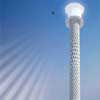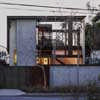Solar Architecture Design, Sustainable Building Opinion, Climate Change News, Progress
Solar Design: Suburban Built Environment
Sustainable Architecture Discussion by Trevor Tucker
1 Dec 2009
Is It Just Gas?
Solar Design
“In China,” a visiting friend began this past Sunday afternoon, “if you are looking for a house and you give up southern exposure, it has to be for something significant. There’s just an expectation there. But we’ve been shocked since being here (in Canada)…all of the houses seem to run along a north-south axis, that is, they face the east and the west.”
It only takes a spark like that to get my ire burning.
Since beginning my novice’s foray into architecture a couple years back, I have been surprised by just how old are many of our sustainable building practices. The concept of solar power has been around, in a small-scale way, since the nineteenth century. Alexander Graham Bell was one of the inventors doing experiments on solar heat, air conditioning, and convection.
And what about Boston architect William Atkinson, who published “The Orientation of Buildings or Planning for Sunlight” and built a “sun house” both in 1912? The house reportedly could reach temperatures of 100 degrees Fahrenheit on freezing days. Solar Homes in the 30s and 40s were widely built throughout the United States using plans from architects such as George Fred Keck.
This of course, is to say nothing of 5000 year-old Egyptian temples with clerestory windows and the Roman baths at Caracalla both of which transmitted heat and light through windows. Vitruvius was adamant about southern orientation.
Move on up to 2009. In the community next door, an elementary school has just been built, which is an exact replica of another on the other side of town. Perhaps they saved money this way. The problem is that the two schools lie on completely different axes. On this one, the south side is almost windowless. It’s as though the school, and all our little would-be green citizens of the future, has snubbed its nose at the sun.
Ten minutes from us our branch of the Canadian Shield, a widely noted geological formation, has been obliterated by dynamite. In any other context, we would call this “catastrophic” or “the barren landscape destroyed by the reality of war”. But this is progress. We pay big bucks for this destruction (the machine that munches up the rock costs $30,000 per week). Then the advertising signs go up: “Heritage Hills”. Why oh why must we call our communities by whatever we destroyed to make them? Briarbrook, Spruce Meadows, Vance Farm.
Some of our local main streets are pure heat traps, with acres of shingled roofs providing unwanted summer heat to houses that then act as barriers to any cooling breezes down the street below. Miles of concrete basements are pored for support and longevity alone, apparently with no regard to the thermal mass or the heat sink potential.
Southern exposure, thermal mass, convection, and working with the landscape are almost absurdly old ideas. It all shocks and puzzles me into my, admittedly cliché, righteous indignation around suburban building practices. Modern architects and developers have been reading about green architecture for decades.
Little caveat from the university where I teach. In the early 70s, when the West was bracing against skyrocketing oil prices, Ottawa U hired an energy manager to increase efficiencies on campus. When the crisis was over, the university decided to stay the course – so the manager was kept on and he just kept making cuts and cuts and savings.
What has made this institution the talk among public works and physical resources professionals is engineering – like its district heating. Since the seventies, each building has been connected by tunnels and excess heat is moved from one to the next. Recently, our engineers found a way to harness the heat from computer servers. Even fish tank water from the aquatic care centre in the Biosciences Complex, an award winner for its energy efficiency, is moved around for air conditioning. It has been called the most energy-efficient university in North America.
Best of all, we were green before it was cool.
Back to suburbia. I admit it: architects and developers deal more in constraints than in grand ideals. Permits, environmental assessments, taxes, let alone the rising cost of wages, equipment and fuel, all must be an accountant’s nightmare. Its perhaps understandable that tweeking the orientation for those extra few degrees gets left out of the equation.
But what happened between 1940 and today? Why the push-back against green living until it became trendy? Why is beauty-less suburban sprawl at its worst in the enlightened West? It is really due to cheap fuel, as some suggest?
The legacy of the industrial revolution was not only the burning of fossil fuels. During Victoria’s reign the terms ‘self-help’ and the ‘self-made man’ were coined, as was “the Lord helps those who help themselves.” Here were individuals that had risen through the ranks of the capitalist endeavour to enjoy their fortunes. The suburbs were their reward.
Walk down the local streets here on a wintry January night in my town after a 15-20 cm dump of snow and you’ll see snowblowers in nearly every driveway, all puffing away at the 100 or so square feet. Every home has a car or two, a lawn mower, a large barbeque. None of it is shared.
Out of communal societies comes communal architecture. The converse is also true.
Maybe you’ve seen the short documentary narrated by George Ferguson, called “Building Britain”. He’s looking at the rejuvenation of Gloucester, England, especially its docks. He travels to Copenhagen, a city of award-winning public spaces, and meets with some architects and city planners to find out what they did to revitalize their downtown core.
Return to the docks at Gloucester and what we see here are many apartment buildings along the waterfront, barely lit at night. No one walks there and there is little structurally to encourage lazy sallies along the banks of the water. He gives his list of lessons learned from Copenhagen to some key figures in this would-be rejuvenation.
The looks are priceless. The contrast in tone between this meeting and the ones he has just had in Copenhagen would be laughable if you didn’t know that these decisions will so greatly affect how people live their day-to-day lives. Deadpan. Resistant. Cold. We the viewers have moved from the light-filled streets of Copenhagen – full of an eclectic mix of people watchers, errand runners, and cyclists – to the dark, quiet, and empty streets of Gloucester. It’s sad because you realize that this isn’t about architecture at all, but about personality…about openness or closedness.
“Its not about the buildings…its about the people, stupid!” says Ferguson in his introduction. It’s also not about the fuel.
Many politicians these days trumpet their vehemence about urban sprawl. But are those of us in the West, especially the Far West, really ready to live in higher density areas and become walkers? More than the cost of oil has to change first. It’s hard to turn a 150-year trend around and sustainable architecture has been knocking at suburbia’s door since its inception. As long as suburban dwellers can’t share their toys, they’ll not share a roof. Sprawl, this constant reaching out for more personal space, and the environmental challenges it proposes, will continue to plague us until architects face off against hyper individualism. As far as I can tell, we’re about as far from the Chinese as it gets.
Solar Design article author – Trevor Tucker
Editor and sessional professor of English literature at the University of Ottawa
Solar Architecture
Solar City Tower, Rio de Janeiro, Brazil
RAFAA architecture & design

image from RAFAA architecture & design
Solar City Tower
Solar Plant Towers, Ivanpah, Mojave Desert, California, USA
RAFAA architecture & design

image from architects
Solar Plant Towers, Ivanpah, Mojave Desert, CA, USA
Solar Umbrella, Venice, Los Angeles, California, USA
Architects: Pugh + Scarpa

photograph : Marvin Rand
Solar Umbrella
Nestled in a neighborhood of single-story bungalows, the Solar Umbrella Residence boldly establishes a precedent for the next generation of Californian modernist architecture. Located on a 41′ wide x 100′-0″ long through-lot, the Solar Umbrella addition transforms the architects’ existing 650 square-foot bungalow into a 1900-square-foot residence equipped for responsible living in the twenty-first century.
More Solar Design posts are welcome
Built Environment Articles – Selection
Sustainable Architecture : main page
Sustainable Buildings – Building Issues : Article by Adrian Welch
Sustainable Design : article by Trevor Tucker. 15 Sep 2009
Sustainable Home Architecture : Lotte Glob House
Comments for the Sustainable Suburban Buildings – Solar Architecture Design page welcome

